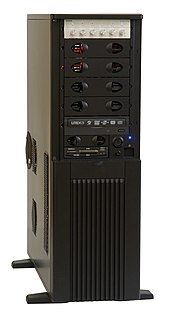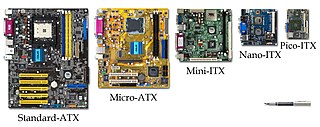
Accelerated Graphics Port (AGP) is a parallel expansion card standard, designed for attaching a video card to a computer system to assist in the acceleration of 3D computer graphics. It was originally designed as a successor to PCI-type connections for video cards. Since 2004, AGP has been progressively phased out in favor of PCI Express (PCIe), which is serial, as opposed to parallel; by mid-2008, PCI Express cards dominated the market and only a few AGP models were available, with GPU manufacturers and add-in board partners eventually dropping support for the interface in favor of PCI Express.

A motherboard is the main printed circuit board (PCB) in general-purpose computers and other expandable systems. It holds and allows communication between many of the crucial electronic components of a system, such as the central processing unit (CPU) and memory, and provides connectors for other peripherals. Unlike a backplane, a motherboard usually contains significant sub-systems, such as the central processor, the chipset's input/output and memory controllers, interface connectors, and other components integrated for general use.

In electronics, a comparator is a device that compares two voltages or currents and outputs a digital signal indicating which is larger. It has two analog input terminals and and one binary digital output . The output is ideally

A graphics card is an expansion card which generates a feed of output images to a display device. Frequently, these are advertised as discrete or dedicated graphics cards, emphasizing the distinction between these and integrated graphics. At the core of both is the graphics processing unit (GPU), which is the main part that does the actual computations, but should not be confused with the graphics card as a whole, although "GPU" is often used as a metonymic shorthand to refer to graphics cards.

A power supply is an electrical device that supplies electric power to an electrical load. The primary function of a power supply is to convert electric current from a source to the correct voltage, current, and frequency to power the load. As a result, power supplies are sometimes referred to as electric power converters. Some power supplies are separate standalone pieces of equipment, while others are built into the load appliances that they power. Examples of the latter include power supplies found in desktop computers and consumer electronics devices. Other functions that power supplies may perform include limiting the current drawn by the load to safe levels, shutting off the current in the event of an electrical fault, power conditioning to prevent electronic noise or voltage surges on the input from reaching the load, power-factor correction, and storing energy so it can continue to power the load in the event of a temporary interruption in the source power.

ATX is a motherboard and power supply configuration specification developed by Intel in 1995 to improve on previous de facto standards like the AT design. It was the first major change in desktop computer enclosure, motherboard and power supply design in many years, improving standardization and interchangeability of parts. The specification defines the dimensions; the mounting points; the I/O panel; and the power and connector interfaces among a computer case, a motherboard, and a power supply.

Mini-ITX is a 17 × 17 cm (6.7 × 6.7 in) motherboard form-factor, developed by VIA Technologies in 2001. They are commonly used in small-configured computer systems. Originally, they were a niche product, designed for fan-less cooling with a low power consumption architecture, which made them useful for home theater PC systems, where fan noise can detract from the cinema experience. The four mounting holes in a Mini-ITX board line up with four of the holes in ATX-specification motherboards, and the locations of the backplate and expansion slot are the same. Mini-ITX boards can therefore often be used in cases designed for ATX, micro-ATX and other ATX variants if desired.
The System Management Bus is a single-ended simple two-wire bus for the purpose of lightweight communication. Most commonly it is found in computer motherboards for communication with the power source for ON/OFF instructions.

BTX is a form factor for motherboards, originally intended to be the replacement for the aging ATX motherboard form factor in late 2004 and early 2005.

Fan control is the management of the rotational speed of an electric fan. In computers, various types of computer fans are used to provide adequate cooling, and different fan control mechanisms balance their cooling capacities and noise they generate. This is commonly accomplished by the motherboards having hardware monitoring circuitry, which can be configured by the end-user through BIOS or other software to perform fan control.

A computer case, also known as a computer chassis, tower, system unit, or cabinet, is the enclosure that contains most of the components of a personal computer.

LPX, originally developed by Western Digital, was a loosely defined motherboard format widely used in the 1990s.

A voltage regulator module (VRM), sometimes called processor power module (PPM), is a buck converter that provides microprocessor and chipset the appropriate supply voltage, converting +3.3 V, +5 V or +12 V to lower voltages required by the devices, allowing devices with different supply voltages be mounted on the same motherboard. On personal computer (PC) systems, the VRM is typically made up of power MOSFET devices.

WTX was a motherboard form factor specification introduced by Intel at the IDF in September 1998, for its use at high-end, multiprocessor, multiple-hard-disk servers and workstations. The specification had support from major OEMs and motherboard manufacturers and was updated (1.1) in February 1999. As of 2008, the specification has been discontinued and the URL www.wtx.org no longer hosts a website and has not been owned by Intel since at least 2004.

Small form factor is a term used for desktop computers, and their enclosures and motherboards, to indicate that they are designed in accordance with one of several standardized computer form factors intended to minimize the volume and footprint of a desktop computer compared to the standard ATX form factor.

Molex connector is the vernacular term for a two-piece pin and socket interconnection. Pioneered by Molex Connector Company, the two-piece design became an early electronic standard. Molex developed and patented the first examples of this connector style in the late 1950s and early 1960s. First used in home appliances, other industries soon began designing it into their products from automobiles to vending machines to mini-computers.

The Macintosh Quadra 605 is a personal computer designed, manufactured, and sold by Apple Computer, Inc. from October 1993 to July 1996. The model names reflect a decision made at Apple in 1993 to follow an emerging industry trend of naming product families for their target customers – Quadra for business, LC for education, and Performa for home. Accordingly, the Performa 475 and 476 was sold in department stores and electronics stores such as Circuit City, whereas the Quadra was purchased through an authorized Apple reseller.

A power supply unit (PSU) converts mains AC to low-voltage regulated DC power for the internal components of a computer. Modern personal computers universally use switched-mode power supplies. Some power supplies have a manual switch for selecting input voltage, while others automatically adapt to the mains voltage.

Mini ATX or Mini-ATX is a generic name used by motherboard manufacturers to describe a small motherboard.
The Dell XPS 730x is an eXtreme Performance System for gaming and high-performance computing released November 16, 2008 and ended life in August 2009. The XPS 730 series was unique in that they had user-serviceable non-proprietary standard ATX-size computer components that allowed the user to upgrade the components through an Exchange Program.
















